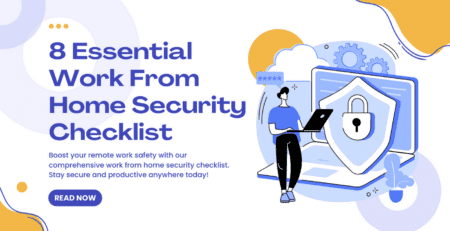I. Introduction
Are you ready to unlock the secrets of continuous learning in remote work? As the digital landscape continues to evolve, staying ahead of the curve is essential for success. In this blog post, we’ll explore the importance of continuous learning in remote work and provide practical strategies and techniques to foster professional growth.
From cultivating a growth mindset to leveraging online resources, we’ll delve into how continuous learning can enhance your remote work experience and open doors to new opportunities.
The Necessity of Continuous Learning
But here’s the kicker: with this new way of working comes new challenges. One of them is continuous learning. In the remote work landscape, continuous learning in remote work is a necessity, not just a fancy buzzword.
A Personal Journey Towards Continuous Learning
Now, let me share a little story with you. A few years back, I was stuck in a rut in my remote job. I felt like I was running on a treadmill, going nowhere fast. Then, I stumbled upon the concept of continuous learning.
The Transformative Power of Continuous Learning
I started taking online courses, reading industry-related articles, and participating in webinars. Guess what? It was a game-changer! My productivity skyrocketed, my job satisfaction improved, and I was even promoted to a leadership role!
The Journey Ahead
So, if you’re ready to unlock your potential and supercharge your remote work experience, stick around. In this article, we’ll explore the importance of continuous learning in remote work. We’ll dive deep into implementing continuous learning strategies in remote teams. We’ll also tackle how to overcome the challenges that come with it. So, buckle up, and let’s get started!
II. The Importance of Continuous Learning in Remote Work
Let’s kick things off with a question. What’s the secret sauce to career advancement in the remote work world? You guessed it, it’s continuous learning. It’s like a magical key that unlocks doors to new opportunities. It helps you stay relevant, improve your job performance, and increase your chances of landing better job roles.
The Perks of Continuous Learning in Remote Work
Now, you might be wondering, “What’s in it for me?” Well, continuous learning in remote work has a ton of benefits. It expands your skill set, increases knowledge retention, and sparks new ideas. It’s kind of like adding more tools to your toolbox. The more tools you have, the more tasks you can tackle, right?
Preparing for the Future of Work
But here’s the real kicker. Continuous learning prepares you for the future of work. It’s like having a crystal ball that helps you stay ahead of the curve. With the rapid changes in the job market, it’s more important than ever to keep learning and adapting.
A Personal Insight
Remember my story from the introduction? Implementing continuous learning strategies in my remote team was a game-changer. It not only boosted our productivity but also prepared us for future challenges. So, if you’re ready to take your remote work experience to the next level, continuous learning is the way to go!
III. Challenges of Continuous Learning in Remote Work Environments
Embarking on a journey of continuous learning while working remotely? Brace yourself for some bumps on the road. It’s like trying to read a book in a room full of distractions. You’ve got your family, pets, doorbells, and let’s not forget, the ever-so-tempting Netflix. Then there’s the challenge of unstable internet connections, making your online learning sessions feel like buffering YouTube videos.
A Personal Tale of Triumph
Let me take you back to when I first started implementing continuous learning strategies in my remote team. Picture this: a team scattered across different time zones, juggling work deadlines, and trying to squeeze in learning sessions. It felt like trying to solve a Rubik’s cube while riding a rollercoaster. But, we didn’t let these challenges deter us. Instead, we saw them as puzzles waiting to be solved.
Strategies to Overcome Challenges: A Detailed Guide
So, how did we tackle these challenges? Here’s a step-by-step guide based on our experience.
- Set Clear Learning Goals: We started by setting specific learning goals. It’s like having a roadmap for your learning journey. It helps you stay focused and motivated.
- Create a Learning Schedule: Next, we created a learning schedule. This helped us manage our time effectively. It’s like having a personal assistant telling you when it’s time to learn.
- Find a Quiet Learning Space: We made sure we had a quiet and comfortable space for learning. It’s like creating a mini classroom in your home.
- Use Reliable Online Platforms: Finally, we used reliable online platforms for our learning sessions. It’s like having a personal tutor available 24/7.
Remember, every challenge is an opportunity for growth. So, don’t let these obstacles deter you from your continuous learning journey. After all, it’s the challenges that make the journey interesting, right?
IV. Leadership Role in Fostering Continuous Learning in Remote Work
Leadership is the backbone of a learning culture. It’s the leaders who set the tone, create the environment, and provide the resources necessary for continuous learning. They are the ones who inspire their teams to strive for knowledge and growth. They understand that learning is not a one-time event but a continuous process that needs to be integrated into the daily workflow.
Secrets Exposed For Leading Different Types Of People Effectively
How Leaders Can Inspire and Facilitate Continuous Learning
Leaders can inspire continuous learning in several ways. First, they can model a commitment to ongoing growth. When leaders are seen as lifelong learners, it encourages their teams to adopt a similar mindset. They can also provide regular feedback and coaching, which are essential for learning and development.
Moreover, leaders can create an environment where employees feel safe to fail. This is crucial because learning often involves making mistakes and learning from them. They can also promote learning as a shared responsibility, encouraging team members to learn from each other

Real-life Examples of Successful Leadership Fostering Continuous Learning
There are many real-life examples of successful leadership fostering continuous learning. For instance, some companies reward continuous learning, provide meaningful and constructive feedback, lead by example, and hire curious people. These strategies have proven to be effective in creating a culture of continuous learning.
- Microsoft: Under the leadership of Satya Nadella, Microsoft underwent a significant cultural shift. Nadella encouraged a growth mindset among his employees, promoting the idea that skills can be developed through hard work and continuous learning.
- Google: Google has always been a strong advocate for continuous learning. They offer their employees various learning and development programs and encourage them to spend 20% of their time on side projects to foster innovation and learning.
- AT&T: AT&T launched a massive retraining program to help their employees upgrade their skills and adapt to the rapidly changing technology landscape. This initiative, driven by their leadership, underscores the importance of continuous learning in today’s work environment.
- General Electric: GE has a long history of investing in employee development. Their Crotonville campus is a testament to their commitment to continuous learning. Here, employees can participate in various leadership and development programs.
- IBM: IBM has a robust learning and development program. They offer a wide range of learning resources, including an AI-powered learning platform that provides personalized learning experiences for their employees.
These examples demonstrate how leadership plays a crucial role in fostering a culture of continuous learning. By setting the right example and providing the necessary resources and support, leaders can inspire their teams to embrace continuous learning and drive their personal and professional growth.
V. Implementing Continuous Learning Strategies in Remote Teams
The world of remote work is a vast ocean of opportunities, but it’s not without its challenges. One of the key elements to thriving in this environment is continuous learning. But how do we embed this into our daily routine? Here’s a step-by-step guide:
- Create a Culture of Continuous Learning: This is the foundation. Encourage curiosity and reward learning. Make it clear that it’s not just about doing the job, but also about growing and developing. This can be done through regular team meetings, where everyone shares something new they’ve learned.
- Empower Employees to Lead Their Own Learning: Give your team the autonomy to choose what they want to learn. This will make the learning process more engaging and relevant. Provide resources and time for self-directed learning.
- Connect Learning to Career Advancement: Show your team how continuous learning can lead to new opportunities and career growth. This will give them a strong motivation to learn.
- Use Technology to Facilitate Learning: There are numerous online platforms and tools that can make learning easy and accessible. Use them to your advantage.
Building a Learning and Development Culture in Remote Workplaces
Building a learning culture in a remote workplace is like planting a garden. It requires time, patience, and the right conditions. Here are some tips to help you cultivate this culture:
- Define Your Learning Culture: What does learning mean in your organization? What are the expectations? Defining this will give your team a clear direction.
- Provide Learning Opportunities: This could be in the form of online courses, webinars, or workshops. Make sure these opportunities are easily accessible to your team.
- Encourage Collaboration: Learning doesn’t happen in isolation. Encourage your team to share their knowledge and learn from each other. This can be done through virtual meetings or online forums.
- Recognize and Reward Learning: Recognize those who take the initiative to learn and grow. This will motivate others to do the same.
Case Studies of Successful Implementation of Continuous Learning Strategies
Let’s take a look at some real-world examples of how continuous learning strategies have been successfully implemented in remote teams.
- GitLab: GitLab, a fully remote company, has built a strong remote work culture by defining its values and continuously updating them. They have created a psychologically safe space where employees can learn and grow.
- Calendar.com: They have fostered a development culture by understanding what their employees want and assessing their learning preferences. They have also considered the power of group training.
- WorkRamp: They have created a sense of learning and development community by publicizing the rewards of learning, building a collaborative knowledge library, and balancing formal and informal learning.
Implementing continuous learning strategies in remote teams is not just about providing learning opportunities. It’s about creating a culture that values learning and provides the right support and resources to facilitate it. It’s about making learning a part of the daily work routine. And as we’ve seen from the case studies, it’s a strategy that leads to success.

VI. Current and Future Trends in Remote Work and Continuous Learning
The world of work is changing rapidly, and remote work is at the forefront of this transformation. The rise of digital technology has made it possible for people to work from anywhere, leading to a surge in remote work. This trend is not just a temporary response to the pandemic; it’s a fundamental shift in how we work. According to a report by Business News Daily, more companies are investing in remote work options, indicating that this trend is here to stay.
In parallel, continuous learning has become a critical aspect of remote work. As the job market becomes more competitive and the pace of technological change accelerates, workers need to continually update their skills to stay relevant. This trend is reflected in the growing popularity of online learning platforms, which allow remote workers to learn new skills and knowledge at their own pace.
Predictions for the Future of Remote Work and Continuous Learning
Looking ahead, the future of remote work and continuous learning seems promising. According to a Forbes article, 25% of all professional jobs in North America will be remote by the end of 2022. This trend is likely to continue, with technological advances such as AI playing a major role in managing remote staff.
In terms of continuous learning, the future is also bright. As remote work becomes more prevalent, the demand for online learning resources will continue to grow. Moreover, as AI and automation become more integrated into the workplace, workers will need to learn new skills to work effectively with these technologies.
How Remote Workers Can Stay Ahead of These Trends
Staying ahead of these trends requires a proactive approach. Remote workers can take advantage of online learning resources to continually update their skills and knowledge. They can also seek out opportunities for professional development, such as online courses or webinars, to stay up-to-date with the latest trends in their industry.
Furthermore, remote workers can leverage technology to enhance their productivity and work-life balance. For example, they can use project management tools to stay organized, communication tools to stay connected with their team, and wellness apps to maintain their mental health.
Implementing continuous learning strategies in remote teams can also help remote workers stay ahead of these trends. By fostering a culture of learning and development, remote teams can ensure that they are always equipped with the skills and knowledge they need to succeed in the evolving world of work.
VII. Conclusion: Developing a Culture of Continuous Learning in Remote Workforce
We’ve explored the world of remote work and continuous learning, uncovering its importance, benefits, and how it helps with career growth. Continuous learning equips remote workers with the skills they need to succeed in the ever-changing work landscape. It keeps them competitive, adaptable, and ready for the future. But, implementing continuous learning strategies in remote teams comes with challenges. We’ve delved into these hurdles and discovered effective ways to overcome them.
Final Thoughts and Encouragement for Remote Workers to Commit to Continuous Learning
As we wrap up, it’s clear that continuous learning is not just a nice-to-have, but a must-have for remote workers. It’s the fuel that drives personal growth and career advancement in the remote work landscape. So, to all you remote workers out there, I encourage you to embrace continuous learning. Make it a part of your daily routine. Remember, every new skill you learn, and every piece of knowledge you gain, brings you one step closer to your career goals.
How To Manage Time As A Remote Worker For Productivity
Action for Readers to Implement the Strategies Discussed
Now, it’s your turn. Start implementing the continuous learning strategies we’ve discussed. Create a learning plan, set learning goals, and start exploring the wealth of learning resources available online. Remember, the journey of continuous learning is a marathon, not a sprint. So, take it one step at a time, and before you know it, you’ll see the transformative power of continuous learning in your career.
Further Reading
For those of you who want to delve deeper into this topic, here are some books that I highly recommend:
The Fifth Discipline: The Art & Practice of The Learning Organization by Peter M. Senge
Never Stop Learning: Stay Relevant, Reinvent Yourself, and Thrive by Bradley R. Staats
Mindset: The New Psychology of Success by Carol S. Dweck (Read Book Summary)
Peak: Secrets from the New Science of Expertise by Anders Ericsson and Robert Pool
Good Leadership Qualities That Everyone Admires: This article discusses the key qualities of a successful leader, including vision, empathy, integrity, resilience, flexibility, and the ability to inspire and motivate others.
10 Surprising Leadership Traits That Define Successful Leaders: This article explores some surprising leadership traits that define successful leaders, including the importance of recognizing and appreciating others’ contributions, fostering a culture of humility and continuous learning, and empowering and developing team members.
Remember, implementing continuous learning strategies in remote teams is a journey, not a destination. So, keep learning, keep growing, and keep pushing the boundaries of what’s possible in your career. Good luck!
References:
- Indeed ↩
- MyGreatLearning ↩
- TogetherPlatform ↩ ↩2
- Deloitte ↩ ↩2
- SptoJobsLink ↩
- Zapier ↩
- Forbes ↩
- IR ↩
- Cultivate a Learning Culture Within Your Organization ↩
- Five Ways Your Managers Can Enable Continuous Learning ↩
- Three Steps HR Leaders Must Take to Inspire Continuous Learning ↩
- How To Promote Continuous Learning In Your Organization ↩
- How Leaders Can Promote Continuous Learning In Today’s Organizations ↩
- 4 Ways to Create a Learning Culture on Your Team ↩
- Remote work: 4 ways leaders can foster continuous learning ↩
- Microsoft’s Growth Mindset ↩
- Google’s Learning Culture ↩
- AT&T’s Retraining Program ↩
- GE’s Crotonville Campus ↩
- IBM’s Learning Platform ↩





